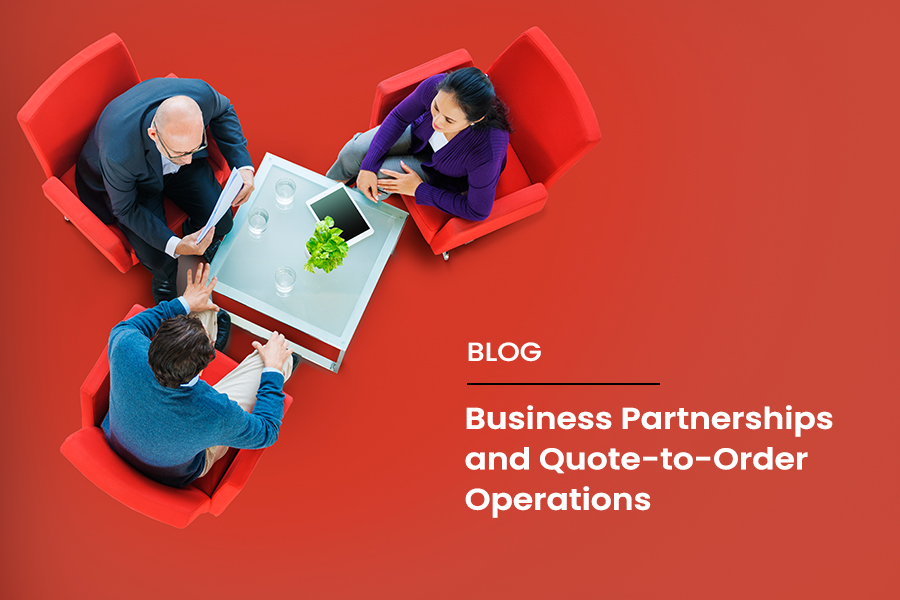Exclusive insider insights for B2B manufacturers on achieving excellence in their ordering process through Quote-to-Order. (Part 1/2)
The insights shared in this blog are first-hand experiences from successful implementation of multiple complex scenarios for a leading building materials manufacturer. The client is a Forbes 500 company.
Our expert Solution Lead, Vineet Jain, outlines a comprehensive end-to-end B2B Business Partner and Quoting scenario. It includes multiple SAP products including SAP Sales and Service Cloud, SAP Commerce Cloud, SAP S/4HANA, SAP Master Data Governance, and SAP CPI.
This is a two-part series in which Vineet will explain Business Partner Management (3 scenarios) in the first blog and end-to-end quoting process (2 scenarios) in the second blog.
Before getting in the details, let’s understand the naming conventions used in the blog.
- Company – An organization (representing the manufacturer here) where the solution is being implemented.
- Customer – An organization (manufacturer, wholesaler, reseller, retailer, etc.) who buys goods and/or services from the company. The customer is maintained as Sold-to-Party, Ship-to-Party, Bill-to-Party or Payer in the system
- Primary Contact – A person who has special privileges to create additional users. Primary contact can represent the customer, request quotation and/or place an order.
- Contact – A person from the customer’s organization who can request a quote or place an order on behalf of the customer or primary contact.
Business Partner Management
In a B2B (Business-to-Business) scenario, a transaction is conducted between the company, who sells its products and/or services, to other businesses/organizations. The buying entity is referred to as a customer in this blog.
Customers
In a B2B model, the customers cannot self-register themselves to create a record in the system. The customers are first verified, and due diligence is performed to validate that the customer is a valid company/organization and is credit-worthy to do business with.
There are three ways the customer can initiate their interest to do business with the company.
- Fill out the Customer Request Form on the SAP Commerce portal, or
- Reach out to the support team via email, or
- Reach out to the support team by calling the helpline number
Scenario 1: Fill out the Customer Request Form on SAP Commerce Portal
This process is initiated by the customer who browses the company’s SAP Commerce portal. They expresses their interest to do business by filling out form on the Commerce portal
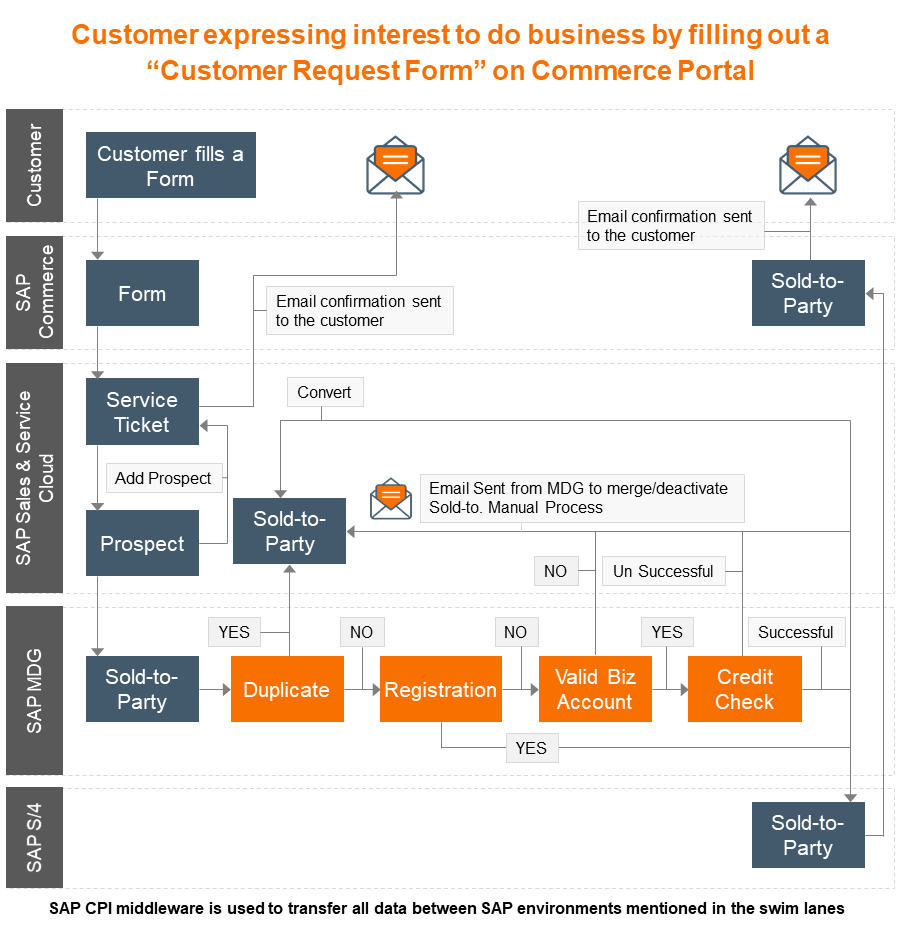
The Commerce system initiates a Service Ticket to SAP’s Sales and Service environment which in return sends the Service Ticket Number to the Commerce environment. This is displayed to the customer as a Service Request Number. The system also sends an email to the customer for future reference. Please note that the Customer record is not yet created either in the Commerce environment or Sales and Service environment.
The Service Agent performs the following actions:
- finds the Service Ticket in the queue (unassociated emails in Sales and Service Cloud)
- converts it to a Service Ticket and assigns the Service Ticket to herself
- creates a Prospect Record in SAP Sales and Service Cloud and assigns the Prospect Record to the Service Ticket.
The creation of the Prospect Record triggers the replication from SAP Sales and Service Cloud to SAP MDG. Please note that the Prospect Record does not reach SAP S/4 HANA environment yet.
The Master Data Team performs the following actions:
- validates the Prospect Record by checking if the record is not a duplicate one (not existing in the company’s database).
- if the record is unique, they reach out to the Prospect to request their company registration details, tax Identification numbers and their shipping locations and billing addresses (required for creating ship-to, bill-to and payer records when approved).
- after reviews and approvals, the master data team performs a credit check.
In any of the above steps, if the master data team rejects the request, it sends an email to the service agent to purge the Prospect Record from Sales and Service Cloud.
After all successful checks have been performed, the master data team confirms and sends the Prospect Record from SAP MDG to S/4 HANA environment which creates a customer record of type Sold-to-Party with a Central Block so that the records are not updated back in Sales and Service Cloud.
The Finance and Materials Management Team:
- maintains Ship-to, Bill-to, Payer, Plant, Warehouse, Tax ID, Pricing relevant settings etc. in the Customer record.
Finally, the Customer Central Block is removed from the customer record, and this triggers an update back to the Sales and Service Cloud and SAP Commerce environment.
Customer Block - For a seamless end-to-end quote to invoice process, it is imperative to maintain all the necessary details in Customer Master record by the Finance team, Master Data team, Materials Management team and Pricing team. Unless these details are not maintained, the customer record stays within the central block in SAP S/4HANA. These updates are not sent to SAP Sales and Service Cloud and SAP Commerce.
When the customer record is updated as a Customer in Sales and Service Cloud, the territory management rules are triggered, and the territory along with the Sales Team (Sales Manager, Sales Rep etc.) are automatically assigned the Prospect Record. A workflow email can also be configured to trigger the Sales Team of Prospect record being updated to a customer so that they can start reaching out to the customer for doing business.
When the customer record reaches the SAP Commerce environment, two emails are sent to the customer; one with Commerce Portal URL and User ID for the Commerce portal and the other with the System Generated Password. The primary users of the customer will have the ability to add/remove more users from their organization to request quote or place orders from the Commerce portal.
Scenario 2: Reach out to the support team via Email
The customer initiates his interest to do business by sending an email (provided on the Commerce portal).
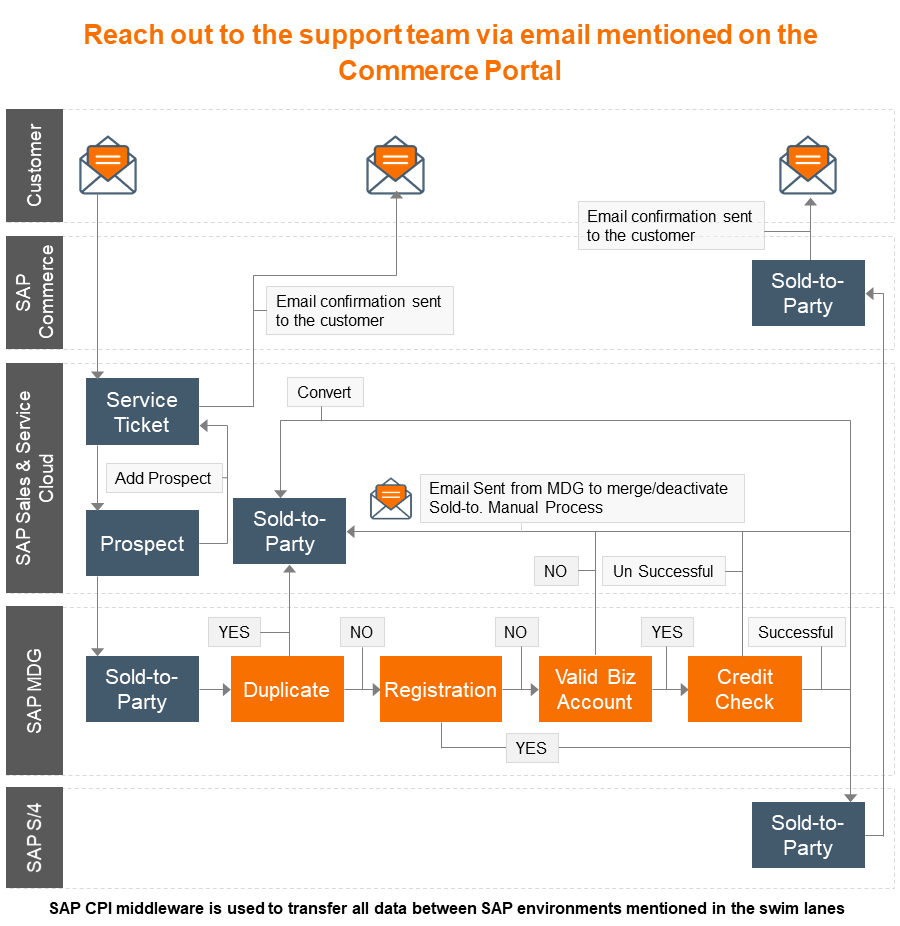
The email is received in the Unassigned Email Queue in Sales and Service Cloud. The service agent monitors this queue frequently and converts the email to a Service Ticket for further action. The agent may reach out to the customer to gather further inputs. All other steps in the process remain the same as mentioned in Scenario 1.
Scenario 3: Reach out to the Support team by calling the helpline number
The customer expresses his interest to do business with the company by calling the helpline number, provided on the Commerce portal.
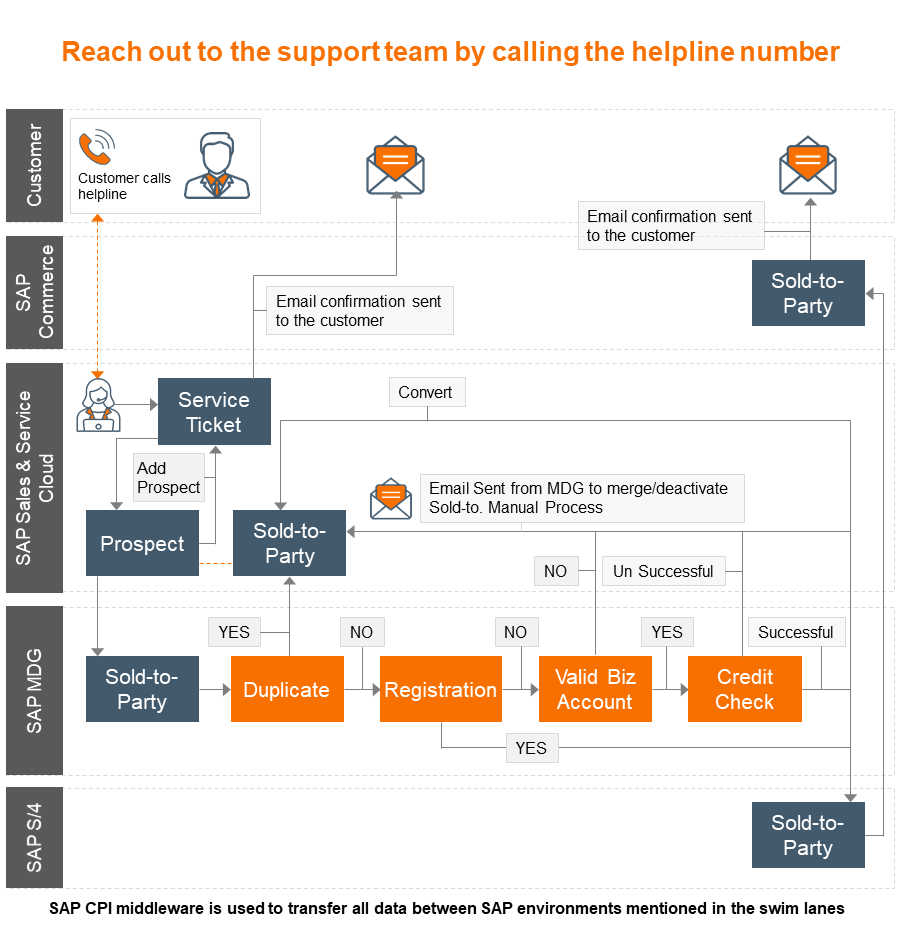
When the Service Agent receives the call, s/he captures all details in the Prospect Record and links the Prospect to Service Ticket. All other steps in the process remain the same as mentioned in Scenario 1.
Contacts
In such a complex environment, it is important to ensure that the contacts in all environments are synchronized in all the linked environments, so when the transaction records are sent between each other, they don’t fail.
There are two use cases for Contact Creation:
- Primary contact of customers in the Commerce portal can add contacts.
- Sales reps and/or service agents can add multiple contacts in the Sales and Service Cloud environment.
Primary Contact of Customer in Commerce Portal add Contacts
Primary contacts of the customer can add Contacts (representatives of the customer) on the Commerce portal. They can request quotes and/or place orders. The Contacts created in SAP Commerce are pushed to SAP Sales and Service Cloud, which in turn are replicated/pushed to SAP S/4 HANA.
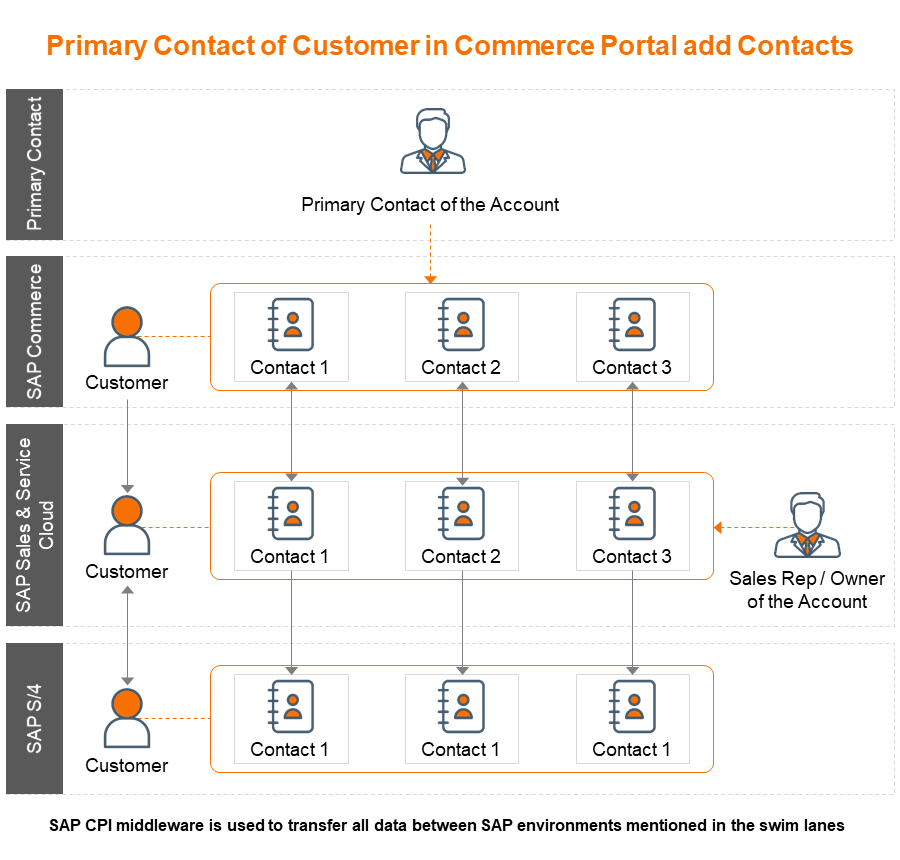
Sales Reps and/or Service Agent can add multiple contacts in Sales and Service Cloud environment
The primary contact of the customer can call the service center or the sales representative of the company to add Contacts in Sales and Service Cloud, which is replicated to Commerce environments and also to backend S/4 HANA. This keeps all three systems synchronized.
In the next blog, Vineet will explain the three scenarios of the Quote-to-Order process.
Subscribe to our blog to receive updates on more exclusive insights.

